
Forage is a plant material eaten by grazing livestock. Historically, the term forage has meant only plants eaten by the animals directly as pasture, crop residue, or immature cereal crops, but it is also used more loosely to include similar plants cut for fodder and carried to the animals, especially as hay or silage.

Alopecurus pratensis, known as the meadow foxtail or the field meadow foxtail, is a perennial grass belonging to the grass family (Poaceae). It is native to Europe and Asia.
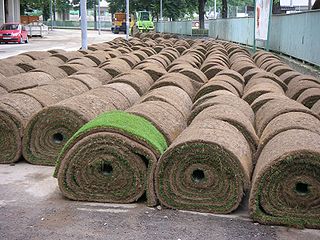
Sod is the upper layer of turf that is harvested for transplanting. Turf consists of a variable thickness of a soil medium that supports a community of turfgrasses.

Festuca (fescue) is a genus of flowering plants belonging to the grass family Poaceae. They are evergreen or herbaceous perennial tufted grasses with a height range of 10–200 cm (4–79 in) and a cosmopolitan distribution, occurring on every continent except Antarctica. The genus is closely related to ryegrass (Lolium), and recent evidence from phylogenetic studies using DNA sequencing of plant mitochondrial DNA shows that the genus lacks monophyly. As a result, plant taxonomists have moved several species, including the forage grasses tall fescue and meadow fescue, from the genus Festuca into the genus Lolium, or alternatively into the segregate genus Schedonorus.

Poa is a genus of about 570 species of grasses, native to the temperate regions of both hemispheres. Common names include meadow-grass, bluegrass, tussock, and speargrass. Poa is Greek for 'fodder'. Poa are members of the subfamily Pooideae of the family Poaceae.
A ligule is a thin outgrowth at the junction of leaf and leafstalk of many grasses and sedges. A ligule is also a strap-shaped extension of the corolla, such as that of a ray floret in plants in the daisy family Asteraceae.

Poa annua, or annual meadow grass, is a widespread low-growing turfgrass in temperate climates. Notwithstanding the reference to annual plant in its name, perennial bio-types do exist. This grass originated as a hybrid between Poa supina and Poa infirma. Major chromosomal rearrangements after polyploidy have contributed to variation in genome size in Poa annua.
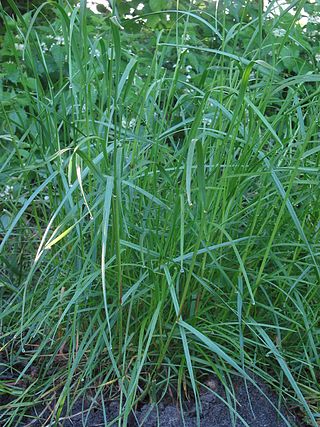
Lolium perenne, common name perennial ryegrass, English ryegrass, winter ryegrass, or ray grass, is a grass from the family Poaceae. It is native to Europe, Asia and northern Africa, but is widely cultivated and naturalised around the world.
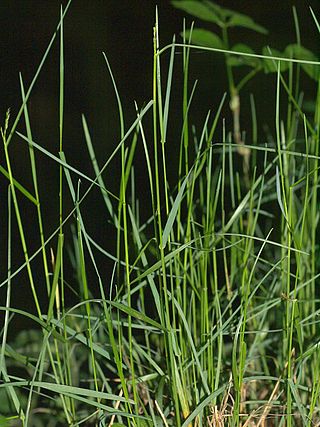
Poa nemoralis, the wood bluegrass, is a perennial plant in the family Poaceae. The late-growing grass is fairly nutritious for livestock, which feed on it in the autumn, and it is used as a lawn grass for shady situations.

Poa trivialis, is a perennial plant regarded in the US as an ornamental plant. It is part of the grass family.
Poa arachnifera, the Texas bluegrass, is a species of grass. It is a dioecious perennial plant, native to the southern Great Plains of the United States.
Magnaporthe poae is an ascomycete fungus which causes the turfgrass disease commonly known as summer patch, or Poa patch. The disease occurs mostly on Kentucky bluegrass (Poa pratensis), Fescues (Festuca sp.), and on Annual bluegrass (Poa annua). Bentgrass may also become infected but shows very few symptoms and quickly recovers. Summer Patch will usually become noticeable between June and September, although small signs can appear at any time but are not noticeable because the turfgrass can recover quickly.
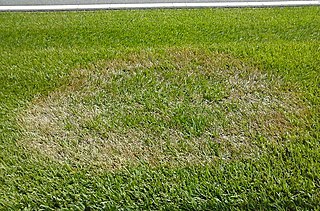
Brown patch is a common turfgrass fungal disease that is caused by species in the genus Rhizoctonia, usually Rhizoctonia solani. Brown patch can be found in all of the cool season turfgrasses found in the United States. Brown patch is most devastating to: Bentgrass, ryegrass, Annual bluegrass, and Tall fescue. Brown patch is also found in Kentucky bluegrass and Fine fescue but this is rare or does minimal damage. Brown patch is known as a foliar disease, so it does not have any effect on the crown or roots of the turf plant.

Poa compressa, the Canada bluegrass or flattened meadow-grass, is a perennial flattened meadow grass, similar to common meadow-grass, Poa pratensis. It is native to Europe but it can be found nearly worldwide as an introduced species. It grows in old wall tops, pavement cracks, dry stony grassland, and many types of wild habitat. It has a flattened stem, 23–30 cm tall, a close one sided panicle of grey green, with purple florets.

Elachista freyerella is a moth of the family Elachistidae that is found in all of Europe, except the Balkan Peninsula. It is also found in North America.
British NVC community OV12 is one of the open habitat communities in the British National Vegetation Classification system. It is one of eight arable weed and wasteland communities of fertile loams and clays.
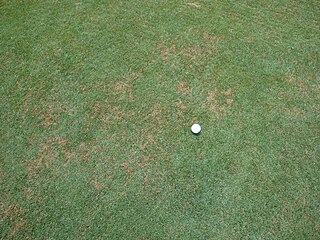
Turf melting out is caused by the fungal pathogen Dreschlera poae, in the family Pleosporaceae. It is a common problem on turfgrass and affects many different species. The disease infects all parts of the plant most commonly on golf course roughs, sports fields, and home lawns. There are two stages of the disease: the leaf blade infection and the crown and root infection Melting out occurs during the cool weather of April and May and is encouraged by high nitrogen fertility. The disease is spread by wind-blown or water splashed spores and survive in thatch.

Brown ring patch is a recently described Rhizoctonia-like disease of turf grass caused by the fungus Waitea circinata var. circinata. The disease primarily affects putting greens and causes yellow or brown rings up to 1 metre (3.3 ft) in diameter. Brown ring patch was first observed in Japan and has since spread to the United States and China (2011).
Bacterial wilt of turfgrass is the only known bacterial disease of turf. The causal agent is the Gram negative bacterium Xanthomonas translucens pv. graminis. The first case of bacterial wilt of turf was reported in a cultivar of creeping bentgrass known as Toronto or C-15, which is found throughout the midwestern United States. Until the causal agent was identified in 1984, the disease was referred to simply as C-15 decline. This disease is almost exclusively found on putting greens at golf courses where extensive mowing creates wounds in the grass which the pathogen uses in order to enter the host and cause disease.






















